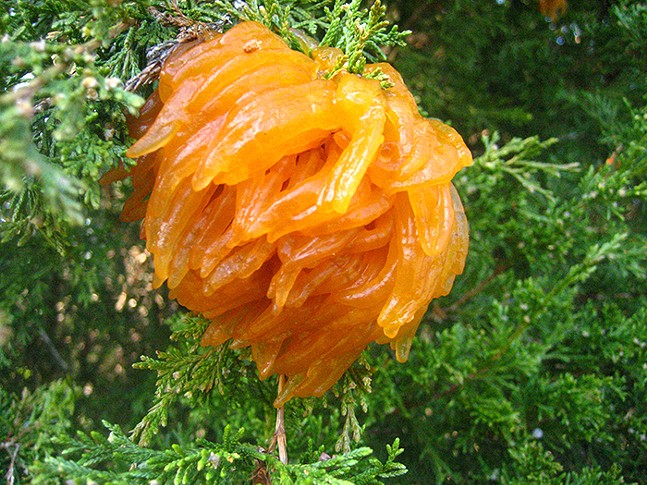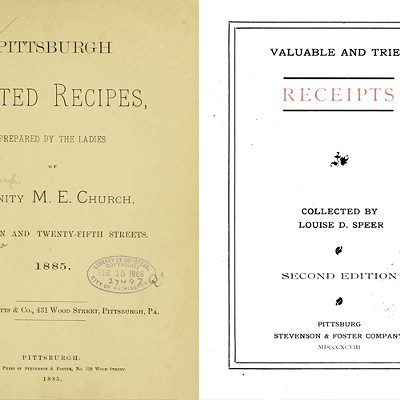Watch out for cedar apple rust, the creepy orange fungus that could damage Pittsburgh trees
There's plenty to watch out for while exploring the Pittsburgh wilderness this summer, including poison ivy and parasites like ticks. One thing humans don't have to worry about, despite its appearance, is cedar apple rust, a bright orange fungus that grows on trees in the spring and summer.
"Usually, you'll see it on the junipers," says Dick Till, an arborist with Davey Tree, a North American professional tree service company with offices in Pittsburgh.
While cedar apple rust looks like something out of a science-fiction movie, it's quite harmless to humans. For area trees, however, it's a whole other matter.
Till adds that, while the fungus manifests on junipers, it usually has little effect on its host. "It doesn't do any harm there, it's just a big, ugly blob and it's disgusting. The more damage they do to the deciduous trees." (Junipers are coniferous, or evergreen trees.)
Till, who has discussed tree care on Talking Trees with Davey Tree, a podcast series hosted by local gardening expert Doug Oster, explains that cedar apple rust will attach to junipers, primarily eastern redcedar, and grow in the spring and summer.
"When the weather starts to warm up, and you have humidity and moisture, they'll start to show up," says Till, adding that the substance will usually start out at the size of a pencil eraser.
From there, they grow up to two inches in diameter. The U.S. Forest Service paints an even more disturbing picture, saying that a "heavily infested redcedar can look a tree decorated for the holidays."
Once the fungus dries out, Till says it releases spores that transfer to other trees, particularly apple and crab apple trees. Because of this, he says anyone with an apple tree or orchard should ensure that there are no wild junipers around, as the fungus could become a "nightmare" for the apple trees.
He says variants of the fungus can also affect quince and hawthorn trees. It commonly causes leaves to fall off.
"It doesn't outright kill [the trees], but if it goes untreated over time, it'll weaken them," says Till. "And then when they're weakened and stressed, you know, they're more susceptible to bores and other pests like that."
This is especially relevant to Pittsburgh, a city with an abundant, but threatened urban tree cover. In 2018, the nonprofit Tree Pittsburgh released a report that Allegheny County lost more than 11,000 acres of its tree canopy between 2011-2015. Some of the loss was due to a fungus outbreak (not cedar apple rust), as well as invasive pests, landslides, and development.
On Jan. 4, it was announced that Pittsburgh was among the few cities chosen to receive a Reforestation Hub assessment through a program developed by Cambium Carbon and the Arbor Day Foundation. As reported by the Pittsburgh City Paper, the assessment seeks to create a “circular urban forestry system” that will create economic opportunities from “healthy forests, restoration of public lands, and the recovery and expansion of the tree canopy.”
As for cedar apple rust, Till says people can "peel" the fungus off, or if the host is a smaller, easy-to-reach tree, use a fungicide to remove it. If there are multiple trees or if the host tree is too tall, you can call in an expert tree service to take care of it.
More concerning, however, are the fallen leaves, as they still have spores that can be blown around.
"You want to get those infected leaves cleaned up because the disease, over the winter, is in the spore stage," says Till. "So it'll lay dormant all winter long until the right weather comes along, and it can release the spores, and then the fun starts again."
"Usually, you'll see it on the junipers," says Dick Till, an arborist with Davey Tree, a North American professional tree service company with offices in Pittsburgh.
While cedar apple rust looks like something out of a science-fiction movie, it's quite harmless to humans. For area trees, however, it's a whole other matter.
Till adds that, while the fungus manifests on junipers, it usually has little effect on its host. "It doesn't do any harm there, it's just a big, ugly blob and it's disgusting. The more damage they do to the deciduous trees." (Junipers are coniferous, or evergreen trees.)
Till, who has discussed tree care on Talking Trees with Davey Tree, a podcast series hosted by local gardening expert Doug Oster, explains that cedar apple rust will attach to junipers, primarily eastern redcedar, and grow in the spring and summer.
"When the weather starts to warm up, and you have humidity and moisture, they'll start to show up," says Till, adding that the substance will usually start out at the size of a pencil eraser.
From there, they grow up to two inches in diameter. The U.S. Forest Service paints an even more disturbing picture, saying that a "heavily infested redcedar can look a tree decorated for the holidays."
Once the fungus dries out, Till says it releases spores that transfer to other trees, particularly apple and crab apple trees. Because of this, he says anyone with an apple tree or orchard should ensure that there are no wild junipers around, as the fungus could become a "nightmare" for the apple trees.
He says variants of the fungus can also affect quince and hawthorn trees. It commonly causes leaves to fall off.
"It doesn't outright kill [the trees], but if it goes untreated over time, it'll weaken them," says Till. "And then when they're weakened and stressed, you know, they're more susceptible to bores and other pests like that."
This is especially relevant to Pittsburgh, a city with an abundant, but threatened urban tree cover. In 2018, the nonprofit Tree Pittsburgh released a report that Allegheny County lost more than 11,000 acres of its tree canopy between 2011-2015. Some of the loss was due to a fungus outbreak (not cedar apple rust), as well as invasive pests, landslides, and development.
On Jan. 4, it was announced that Pittsburgh was among the few cities chosen to receive a Reforestation Hub assessment through a program developed by Cambium Carbon and the Arbor Day Foundation. As reported by the Pittsburgh City Paper, the assessment seeks to create a “circular urban forestry system” that will create economic opportunities from “healthy forests, restoration of public lands, and the recovery and expansion of the tree canopy.”
As for cedar apple rust, Till says people can "peel" the fungus off, or if the host is a smaller, easy-to-reach tree, use a fungicide to remove it. If there are multiple trees or if the host tree is too tall, you can call in an expert tree service to take care of it.
More concerning, however, are the fallen leaves, as they still have spores that can be blown around.
"You want to get those infected leaves cleaned up because the disease, over the winter, is in the spore stage," says Till. "So it'll lay dormant all winter long until the right weather comes along, and it can release the spores, and then the fun starts again."

















